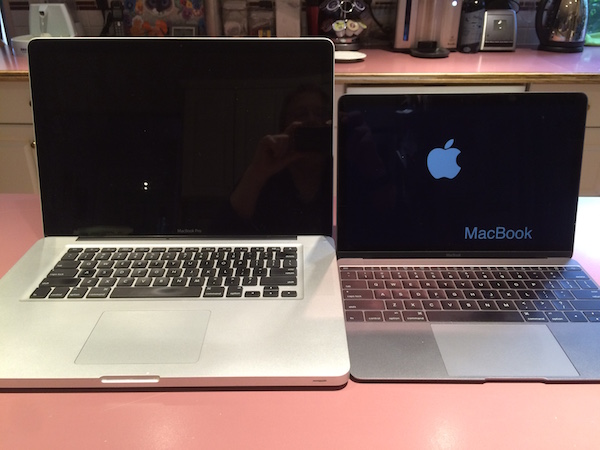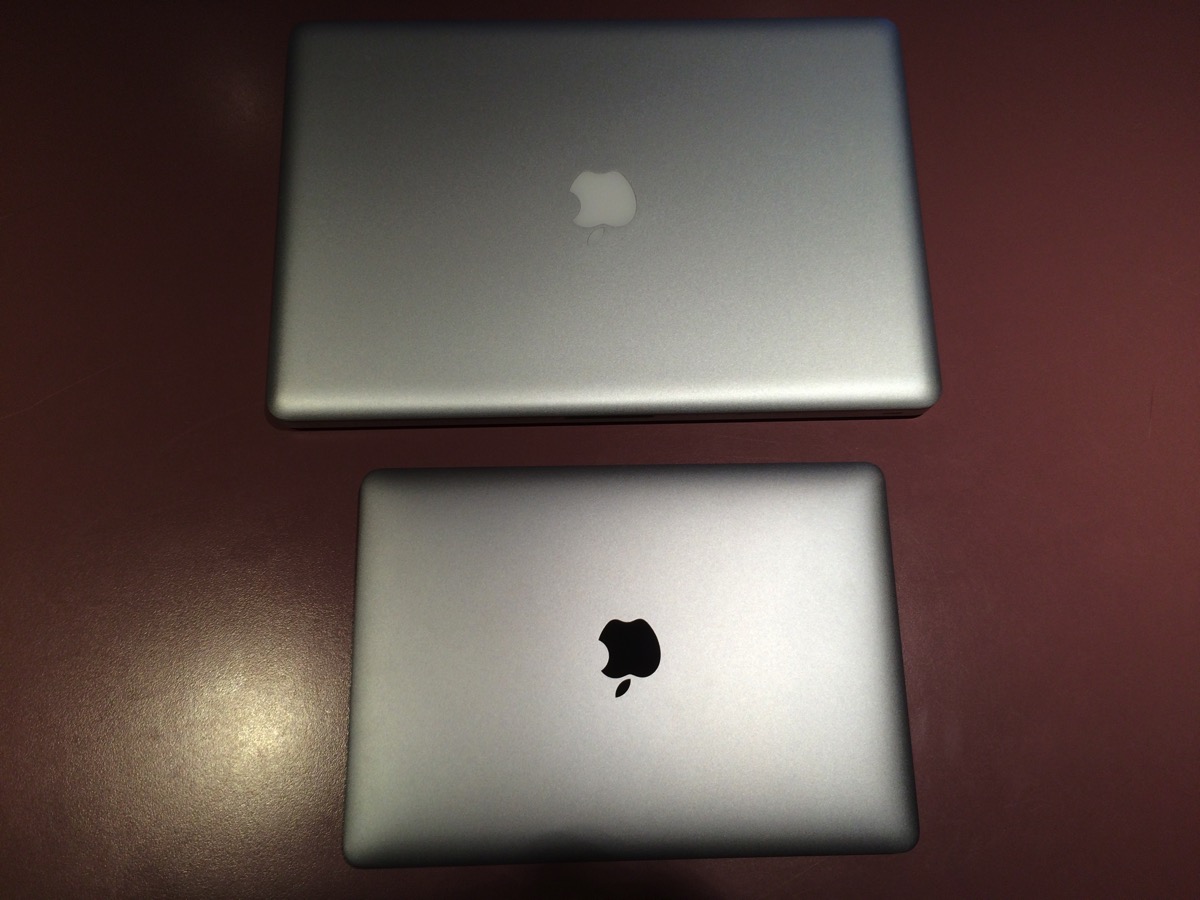I recently upgraded (side graded?) from a circa 2011 MacBook Pro to a 2015 MacBook. This change isn’t for everyone, but I’m pretty happy with the differences. In this post I explore what changed, and why I made the leap.
What led me here
I’ve had two MacBook Pros in the past decade, the most recent purchased in 2011. I also have an iMac, circa 2008, that I almost never use. The Pro has basically been a desktop replacement for all of my personal uses. I use it for all the typical web browsing, photo editing, video editing, website development, trip planning (GPS route editing), and writing. I also carry it with me when I travel, including when I ride my motorbike.
Therein lies the problem: my 15” MacBook Pro is doing everything. And its weaknesses are starting to show: it isn’t powerful enough to deal with large video editing (which I do occasionally), and it is too big and heavy to be convenient to cart around. I never use the iMac because it is actually slower than the MacBook Pro. Yet the MacBook Pro really doesn’t make a very good ‘high performance workstation’, nor is it super portable.
This came to a head for me when two things happened in a relatively short time frame: I worked to assemble a video from my 2013 motorcycle road trip, and shortly thereafter went to Hawaii with my wife. The video editing was made more tedious than it could have been because the 2011 MacBook Pro has a relatively slow processor and slow GPU. It is slow even though I’ve upgraded the memory to 16 GB and installed a higher speed drive with on-board SDRAM cache. The MacBook Pro isn’t a very good high performance workstation.
Then comes the issue of portability. I felt a bit like a sherpa carrying all of my electronic gear through the airport on our trip to and from Hawaii. The 6 pounds or so that the MacBook weighs sounds fairly light, but that becomes less true when you are carrying it around for several hours. And this is even more true on a motorbike: the MacBook Pro isn’t a very good ultra-portable.
I decided to fix one problem at a time. Since I edit video rarely, I would aim to make my main (portable) computer as small and light as practical. Then, when finances permit, I would build a superior workstation, probably centred around a Mac Pro. So step one is a MacBook, with a bit less Pro.
The tale of the tape
| Computer | Height | Width | Depth | Weight |
| 2011 MacBook Pro | 2.41 cm (0.95 inches) | 36.4 cm (14.35 inches) | 24.9 cm (9.82 inches) | 2.54 kg (5.6 pounds) |
| 2015 MacBook | 0.35-1.31 cm (0.14-0.52 inches) | 28.05 cm (11.04 inches) | 19.65 cm (7.74 inches) | 0.92 kg (2.03 pounds) |
2011 MacBook Pro (top) vs 2015 MacBook
2011 MacBook Pro (left) vs 2015 MacBook (right)
The 2015 Macbook is substantially less than half the size of the MacBook Pro. Thinner, lighter, and smaller in every dimension. In fact, it is so light and small that I had to be careful not to toss it around: something which I could never say for the MacBook Pro, which always felt ‘substantial’.
| Computer | Processor | Memory | Disk |
| 2011 MacBook Pro | 2.4 GHz quad-core Intel i7 | 16 GB | 750 GB w/SDRAM cache |
| 2015 MacBook | 1.3 GHz (2.9 GHz Turbo) dual core Intel M | 8 GB | 512 GB PCIe SSD |
There are tradeoffs here, and this is unsurprising. In addition to feeling disturbingly light, the MacBook is almost ridiculously spartan. A single port, no CD/DVD, no fan… it is quite a departure from the Pro version. Although on the surface, the MacBook appears to have about half the processing power, I never observed any performance drop in day-to-day tasks. Most notably, editing and organizing photos in both Aperture ( and, after I ‘upgraded’, Photos) actually seems faster. I would, however, never even try to edit the multi-gigabyte videos I was trying to work on with my MacBook Pro…
2015 MacBook: Pros
Some of the pros for the 2015 MacBook are obvious, some less so. In no particular order:
- light: clocking in at less than a kilogram, the MacBook is comically light. It is 30% lighter than the MacBook Air which weighs over 1.3 kg. This makes carting the thing around a breeze, to the point where my usage has changed. I’m much more inclined to carry the thing out to the deck when I’m sitting there, for example
- small: d’uh. the MacBook is ‘small’ from every angle. It is smaller than the MacBook Air in nearly every dimension. It is much more comparable to a tablet or the old ‘ultrabook/netbook’ devices than to a laptop
- excellent display: although the display is small, it is extremely sharp. It is a Retina display possessing 2304 x 1440 resolution (226 pixels per inch)
- fast SSD: the internal SSD is fast. I haven’t done any performance tests, but the machine starts instantly, and loads my 50+ GB photo library in seconds
- quiet: it has no fan. No disk. no moving parts other than the keyboard, really. It is totally silent, unlike the MacBook Pro would regularly spin up its fan
- cool: the MacBook produces no discernible heat except when it is charging. Again, this is unlike the MacBook Pro, which could become uncomfortably hot, even completely unplugged, sitting on your lap
2015 MacBook: Cons
The MacBook isn’t for everyone. I would say it makes a great second computer, not a great primary computer. Some of the factors that follow feed into this assessment:
- limited processing power: Although the MacBook does a good job performing all basic functions, it isn’t going to do well at processor intensive tasks like video editing. It has, arguably, less than half the processing power of the MacBook Pro (although the retro-sounding ’turbo’ mode seems to hide that well). In day-to-day use it actually feels faster, but I have to believe this is a well-crafted illusion
- the limited processing capability extends to the Intel video processor / GPU. This means that high-end graphics, particularly games, are going to be out of reach
- no internal expansion options: like all newer MacBooks, there are no options here to upgrade either memory or ‘disk’. Buy the biggest memory / largest SSD you can, because you won’t be upgrading later
- only one interface port: the MacBook Pro has a ton of interface options: Ethernet, USB, Lightning, CD/DVD…. The 2015 MacBook has one: a USB-C port that does double duty as your power connector. You can’t connect a single thing to the MacBook (other than an audio headset) without an external dongle. Buy one: you’ll need it
- ultra-low travel keyboard: The keyboard on the MacBook is a marvel of space-crunching engineering. However, you can’t change physics: the keys move a tiny fraction of a millimetre when you press them, and that’s it. The keyboard feel is… odd. It takes more force than you’d expect to activate each key. But it is growing on me. If, however, you are already unhappy with the keyboard feel of a MacBook Pro, you will likely find the MacBook keyboard frustrating
- limited battery life: Apple has increased the battery life on all of their portables for years. The newest MacBook Air and MacBook Pro machines have batteries that last ten or more hours. The 2015 MacBook, however, barely manages about six hours. This is still incredible by the standards of a few years ago, but it is odd and may disappoint some users
Conclusion
I’m very happy with my choice to “downgrade” my portable. I now have ultimate portability: there are no weight or size issues here. Whereas the MacBook Pro was a compromise between portability and power, the 2015 MacBook is no compromise portability. The lack of any ports is a bit extreme to my thinking, and it is possible the USB-C will be supplanted in the future by the USB-C compliant Lightning port that Intel announced recently. But for my purposes, having to hook up a dongle on the reasonably rare instances where I need a DVD drive or external display isn’t going to be an issue.
However, I fully intend to build a high-power workstation at some point for the things that require processing power that the MacBook simply doesn’t have. Again, although the MacBook Pro has/had more processing power, it was a compromise: not nearly as much power as a full on workstation in order to keep it portable.



